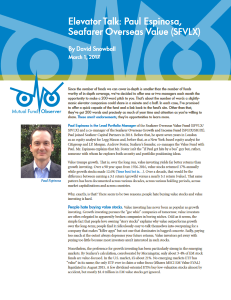Since the number of funds we can cover in-depth is smaller than the number of funds worthy of in-depth coverage, we’ve decided to offer one or two managers each month the opportunity to make a 200 word pitch to you. That’s about the number of words a slightly-manic elevator companion could share in a minute and a half. In each case, I’ve promised to offer a quick capsule of the fund and a link back to the fund’s site. Other than that, they’ve got 200 words and precisely as much of your time and attention as you’re willing to share. These aren’t endorsements; they’re opportunities to learn more.
Paul Espinosa is the Lead Portfolio Manager of the Seafarer Overseas Value Fund and a co-manager of the Seafarer Overseas Growth and Income Fund (SFGIX/SIGIX). Paul joined Seafarer Capital Partners in 2014. Before that, he spent seven years in London as an equity analyst for Legg Mason and, before that, as a New York-based equity analyst for Citigroup and J.P. Morgan. Andrew Foster, Seafarer’s founder, co-manages the fund with Paul. Mr. Espinosa explains that Mr. Foster isn’t the “if Paul get hits by a bus” guy but, rather, someone with whom he explores both security and portfolio positioning ideas.
Value trumps growth. That is, over the long run, value investing yields far better returns than growth investing. Over a 90 year span from 1926-2016, value stocks returned 17% annually while growth stocks made 12.6% (Your best bet is…). Over a decade, that would be the difference between earning a 3:1 return (growth) versus a nearly 5:1 return (value). That same pattern has been documented across various decades, across various holding periods, across market capitalizations and across countries.
Why, exactly, is that? There seem to be two reasons: people hate buying value stocks and value investing is hard.
People hate buying value stocks. Value investing has never been as popular as growth investing. Growth investing pursues the “gee whiz” companies of tomorrow; value investors are often relegated to apparently-broken companies in boring niches. Odd as it seems, the simple fact that people love owning “story stocks” explains why value outperforms growth over the long-term; people find it ridiculously easy to talk themselves into overpaying for a company that makes “killer apps” but not one that dominates in bagged concrete. Sadly, paying too much at the outset always depresses your future returns. Value investors get away with paying too little because most investors aren’t interested in such stocks.
Nonetheless, the preference for growth investing has been particularly strong in the emerging markets. By Seafarer’s calculation, corroborated by Morningstar, only about 3-4% of EM stock funds are value-focused. In the U.S. market, it’s about 28%. No emerging markets ETF has “value” in its name; the only ETF ever to claim a value focus (iShares MSCI EM Value EVAL) liquidated in August 2015. A few dividend-oriented ETFs buy low-valuation stocks almost by accident, but mostly $1.4 trillion in EM value stocks get ignored.
Value investing is hard. The simpleton’s approach to value investing is this: pick one or two or three quantitative measures (low p/e, low p/b, low p/ev), buy 10 stocks that share those characteristics and wait for the magic. As it turns out, that approach fails, which is why deep-value ETFs haven’t worked. Some firms that are priced as if they’re going out of business are actually going out of business. Some firms priced as if they have permanently brain-impaired leadership turn out to have, well … you get it. Tweedy, Browne’s classic review of the research (What has worked in investing, 2009 ed.) identifies at least six separate drivers at play, concluding that while no single factor is independently useful, “Each characteristic seems somewhat analogous to one piece of a mosaic. When several of the pieces are arranged together, the picture can be clearly seen: an undervalued stock.”
Value investing in emerging markets was especially hard. Value traps abounded, legal and regulatory protections were scant, and much of the value locked up in EM companies remained permanently locked away. Mr. Espinosa’s research and Mr. Foster’s experience suggest that emerging markets are evolving in ways that make it possible to now realize more of that traditionally inaccessible value. In On Value in the Emerging Markets, Paul identifies seven possible catalysts which might (or, in any isolated instance, might not) serve to unlock value. One factor, as an example, is that many EM companies are still owned by their founding families; as the founders pass the firm along to the next generation, more and more second-generation owners are hiring professional managers and are open to the possibility of selling, liquidating or divesting underperforming assets. Another is the maturation of local capital markets, which make it increasingly possible for local investors to borrow enough money to simply buy (and reform) an underachieving company.
We asked Mr. Espinosa to talk about what he’s up to, what makes this a Seafarer fund and what makes it not Andrew Foster’s Seafarer fund. Here are Mr. Espinosa’s 400 words on why you should add SFVLX to your due-diligence list:
I’m managing this fund for the reader you talked about, the guy who manages a diner in Montana and who’s thinking about his retirement and his family’s security. This is the core, my personal crusade, for why I want to lead this fund. Government and central bank policies penalize thrift; they’re trying to encourage price inflation through low interest rates but this means purchasing power is declining and many of us are having trouble retiring with dignity. What I’m truly truly trying to do here is to increase the purchasing power of a saver.
The vogue today is for relative return investing. It asks “how did you do relative to a benchmark,” not “has your manager been helping you meet your goals?” I think of myself as a sort of absolute return investor; we’re benchmark-agnostic, our aim is to produce a minimum rate of return that allows our investors to increase their purchasing power.
Andrew and I follow the same process in evaluating companies. What we do within that process is different. I have a much greater focus on capital appreciation driven by changes within my firms, and those are often separate drivers. A growth fund, such as Andrew’s, will mostly follow the trajectory of emerging markets economic growth, buoyed by income and dividends. The Value fund is more likely to grow in a step function; one of our stocks might do nothing for quite a while, then pop when a catalyst takes hold even though its home market isn’t particularly growing. That’s when we might sell and look to redeploy capital in another firm that hasn’t yet appreciated.
The need to find that places where change is just taking hold may lead us into markets where Growth & Income wouldn’t go, including frontier markets, and it might take risks that Growth & Income is not quite ready for, such as leverage risk.
Like Andrew, I’m a bottom-up investor. I’ve worked at large institutional firms where the organization is very structured, very rigid. At Seafarer, the portfolio managers do stock analysis, analysts involved in portfolio construction. I work with the growth investments and he works with the value investments, which helps mentally and allows us to avoid being one-trick ponies. And we’re patient. Demand for the Value product might not take off for ten years, but that’s okay. We’ll do our work, hone our skills, build our record and be there when investors come looking.
A very Seafarer thing.
Seafarer Overseas Value has a $2500 minimum initial investment which is reduced to $1500 for accounts established with an automatic investing plan or $1000 for IRAs and other types of tax-advantaged accounts. Expenses are capped at 1.15% through August 2017. The institutional share class has a $25,000 minimum and expenses capped at 1.05%. The fund has assets of $6.7 million (1/30/17). Seafarer will waive the institutional share class minimum for investors who (1) establish an account with an automatic investing plan, (2) invest directly through Seafarer rather than through a platform, and (3) testify in good faith that they hope to continue investing until they reach the fund’s normal institutional minimum. Here’s the fund’s homepage. Mr. Espinosa has laid out the case for EM value investing in a 2016 white paper, “On Value in the Emerging Markets.” It’s a bit dense for non-technical readers but, with a bit of time, it’s also entirely manageable.













